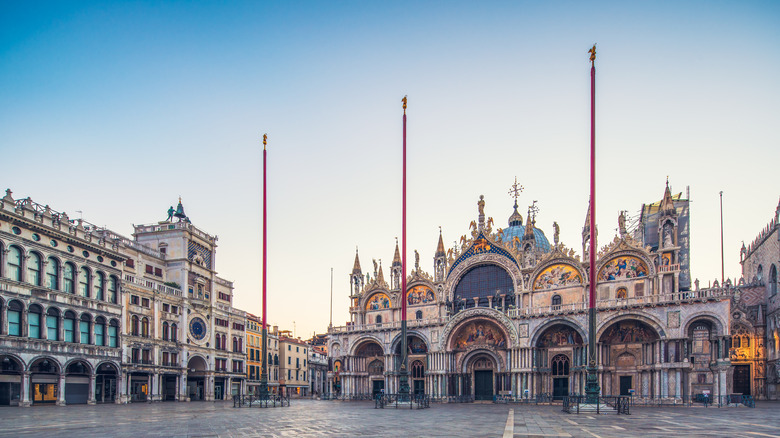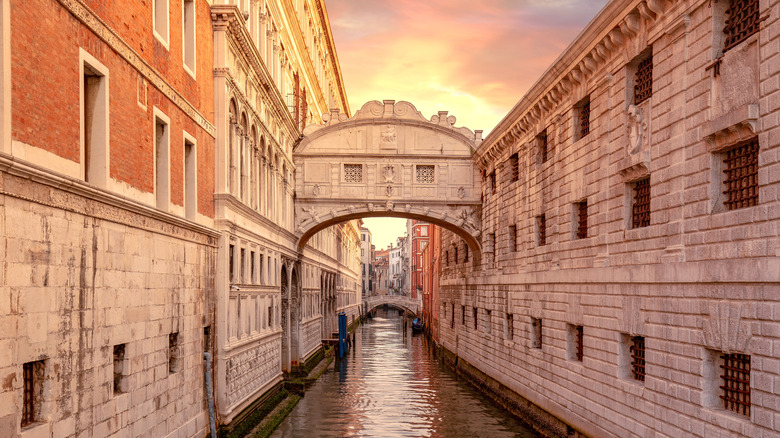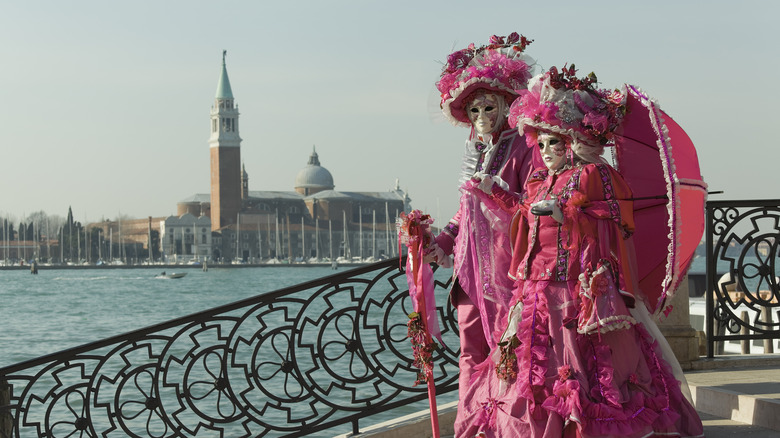This Italian City Is A Great Destination For History Buffs To Add To Their Bucket Lists
The enchanting city of Venice is an Italian destination that cannot be missed. However, there's much more to it than gondola rides, Instagrammable scenery, and food — Venice deserves a spot on every history buff's bucket list. Venice is a designated UNESCO Heritage Site and is known for its intricate network of canals, historic architecture, and deep heritage. With a fascinating legacy dating back over a thousand years, Venice is a place where the past comes alive.
Founded as a refuge for Italians fleeing from invasions in the fifth century, Venice's strategic location on the Adriatic Sea soon transformed it into a powerful maritime republic. In the Middle Ages, Venice's merchant fleet navigated the Mediterranean, establishing trade routes that extended as far as East Asia. The city became a wealthy trading hub, fostering economic growth and a vibrant cultural exchange. This period of prosperity led to the construction of some of Venice's most important landmarks across its 118 islands, which remain to this day.
St. Mark's Square, also known as Piazza San Marco, is the bustling heart of Venice and an essential stop. This grand square dates back to the 12th century and has long served as the city's social and political center. Its rich history includes being a gathering place for the Venetian aristocracy and a hub for trade and diplomacy during the height of the Venetian republic. Visitors can ascend the Campanile bell tower for panoramic views of the city and later explore some of the surrounding sights.
St. Mark's Basilica and the Doge's Palace
One of the most magnificent pieces of Venetian history is St. Mark's Basilica, which is often referred to as "the church of gold." This architectural masterpiece goes back to the Byzantine era — construction began in 1063. Its breathtaking façade features intricate artwork, golden domes, and marble columns. It's a sight to behold. Inside, the basilica continues to mesmerize. Its interior features the Pala d'Oro, a sublime gold altarpiece, and over 4,000 square meters of mosaics depicting biblical scenes and stories of Venice's patron saint, St. Mark. Entrance is free; however, guided tours are highly recommended for their educational value (and for avoiding long lines).
Adjacent to St. Mark's Basilica, the Doge's Palace is a Gothic masterpiece that served as the residence of the doge, the elected leader of the Venetian Republic. A visit offers a glimpse into the political life of Venice, where the Council of Ten ruled the city. The palace includes the doge's apartments, the Grand Council Hall, and many other rooms and collections. It also houses "Paradise" by Tintoretto, one of the largest oil paintings in the world. A highlight of the tour is crossing the Bridge of Sighs, which leads to Venice's historic prisons. The bridge earned its name from the sighs of prisoners as they caught their last glimpse of Venice before incarceration. It's worth purchasing the €40 Museum Pass, which grants access to many other civic museums of Venice, including the Doge's Palace.
A historical foray into Venetian art and culture
The Gallerie dell'Accademia offers an aesthetic journey from the Middle Ages to the Renaissance — a destination that should be on every art lover's bucket list. After all, the city was home to celebrated artists like Titian, Tintoretto, Giovanni Bellini, and many more. Venice's cultural scene extends to Carnival, an annual February tradition dating back to the 11th century. It's a 10-day celebration filled with elaborate masks and grand costumes. Anyone can join its famous masquerade balls, but tickets range from €300 to €3,000 or more per person — and that's without budgeting for the outfit!
Venice is also home to one of the world's earliest ghettos, a term that originated here and was originally a reference to the Venetian foundries. Established in the 16th century, the Venetian Ghetto was a place where Jewish residents were required to live. However, it was a haven of tolerance in its time. Different Jewish communities coexisted peacefully, fostering exchange and learning. Today, the Venetian Ghetto is a historical and cultural site that welcomes visitors to explore its synagogues and learn about Venice's Jewish community.
Venice's beauty, history, and cultural significance make it an essential destination. Its narrow alleyways and picturesque buildings reveal layers of antiquity, from the grandeur of the Venetian republic to the artistic achievements of the Renaissance. For history enthusiasts, Venice is a living museum where the past intertwines with the present, offering an unforgettable journey through the canals of time.


